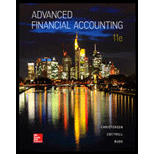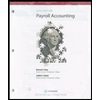
Advanced Financial Accounting
11th Edition
ISBN: 9780078025877
Author: Theodore E. Christensen, David M Cottrell, Cassy JH Budd Advanced Financial Accounting
Publisher: McGraw-Hill Education
expand_more
expand_more
format_list_bulleted
Question
Chapter 17, Problem 17.4Q
To determine
Expendability of resources: The major difference between commercial and governmental accounting is, in commercial enterprises, the measurement focus is on the flow of all economic resources of the firm, where as in governmental entities focus will be on expendability of resources, this measurement focus concentrates on flow of current financial resources and their proper expendability for designated purpose. The modified accrual basis is used to recognize revenue and expenses.
To explain:which basis of accounting is used for funds for which expendability is concern.
Expert Solution & Answer
Want to see the full answer?
Check out a sample textbook solution
Students have asked these similar questions
Can you solve this general accounting problem using appropriate accounting principles?
Can you solve this general accounting question with the appropriate accounting analysis techniques?
QUESTION SIX
a) Explain the difference between absorption costing and marginal costing (6 marks)
b) Alan Ltd. the producer of a single mile product has provided the following cost structure data
based on the normal or budgeted level of output of 60,000 litres
Cost per unit in Euros
8
Material cost
Direct labour
6
Variable overheads
10
Selling and distribution costs per unit
4
Fixed manufacturing overheads
8
Total
36
Page 4 of 5
Chapter 17 Solutions
Advanced Financial Accounting
Ch. 17 - Prob. 17.1QCh. 17 - What are the nine funds that local and state...Ch. 17 - Compare the modified accrual basis with the...Ch. 17 - Prob. 17.4QCh. 17 - When are property taxes recognized as revenue in...Ch. 17 - Prob. 17.6QCh. 17 - Prob. 17.7QCh. 17 - Are all expenditures encumbered?Ch. 17 - Prob. 17.9QCh. 17 - Prob. 17.10Q
Ch. 17 - When is the expenditure for inventories recognized...Ch. 17 - Prob. 17.12QCh. 17 - Prob. 17.13QCh. 17 - Prob. 17.14QCh. 17 - Prob. 17.15QCh. 17 - Prob. 17.1CCh. 17 - Prob. 17.2CCh. 17 - Prob. 17.3CCh. 17 - Prob. 17.1.1ECh. 17 - Prob. 17.1.2ECh. 17 - Prob. 17.1.3ECh. 17 - Prob. 17.1.4ECh. 17 - Prob. 17.1.5ECh. 17 - Prob. 17.2ECh. 17 - Prob. 17.3.1ECh. 17 - Prob. 17.3.2ECh. 17 - Prob. 17.3.3ECh. 17 - Prob. 17.3.4ECh. 17 - Prob. 17.3.5ECh. 17 - Prob. 17.3.6ECh. 17 - Prob. 17.3.7ECh. 17 - Prob. 17.3.8ECh. 17 - Prob. 17.3.9ECh. 17 - Prob. 17.3.10ECh. 17 - Prob. 17.4.1ECh. 17 - Prob. 17.4.2ECh. 17 - Prob. 17.4.3ECh. 17 - Prob. 17.4.4ECh. 17 - Prob. 17.4.5ECh. 17 - Prob. 17.4.6ECh. 17 - Prob. 17.4.7ECh. 17 - Prob. 17.4.8ECh. 17 - Prob. 17.4.9ECh. 17 - Prob. 17.4.10ECh. 17 - Prob. 17.5ECh. 17 - Prob. 17.6ECh. 17 - Prob. 17.7ECh. 17 - Computation of Revenues Reported on the Statement...Ch. 17 - Prob. 17.9ECh. 17 - Prob. 17.10ECh. 17 - Prob. 17.11ECh. 17 - Prob. 17.12ECh. 17 - General Fund Entries [AICPA Adapted] The following...Ch. 17 - Prob. 17.14PCh. 17 - Prob. 17.15PCh. 17 - Prob. 17.16PCh. 17 - Prob. 17.17PCh. 17 - Prob. 17.18.1PCh. 17 - Prob. 17.18.2PCh. 17 - Prob. 17.18.3PCh. 17 - Prob. 17.18.4PCh. 17 - Prob. 17.18.5PCh. 17 - Prob. 17.18.6PCh. 17 - Prob. 17.18.7PCh. 17 - Prob. 17.18.8PCh. 17 - Prob. 17.18.9PCh. 17 - Prob. 17.18.10PCh. 17 - Prob. 17.18.11PCh. 17 - Prob. 17.18.12PCh. 17 - Prob. 17.18.13PCh. 17 - Prob. 17.18.14PCh. 17 - Prob. 17.18.15PCh. 17 - Prob. 17.18.16PCh. 17 - Prob. 17.18.17PCh. 17 - Prob. 17.18.18PCh. 17 - Prob. 17.18.19PCh. 17 - Prob. 17.18.20PCh. 17 - Prob. 17.18.21PCh. 17 - Prob. 17.18.22PCh. 17 - Prob. 17.18.23PCh. 17 - Prob. 17.18.24PCh. 17 - Prob. 17.18.25PCh. 17 - Prob. 17.18.26PCh. 17 - Prob. 17.18.27PCh. 17 - General Fund Entries [AICPA Adapted] DeKalb City...Ch. 17 - Prob. 17.18.29PCh. 17 - Prob. 17.18.30PCh. 17 - Prob. 17.18.31PCh. 17 - General Fund Entries [AICPA Adapted] DeKalb City...Ch. 17 - Prob. 17.18.33PCh. 17 - Prob. 17.18.34PCh. 17 - Prob. 17.18.35PCh. 17 - General Fund Entries [AICPA Adapted] DeKalb City...Ch. 17 - Prob. 17.18.37PCh. 17 - Prob. 17.18.38PCh. 17 - Prob. 17.18.39PCh. 17 - Prob. 17.19PCh. 17 - Prob. 17.20P
Knowledge Booster
Similar questions
- Ericsson Company has a predetermined overhead rate of 152% of direct labor cost. Estimated overhead for the period was $275,000. The actual cost for direct labor was $194,000 and the actual overhead was $283,000. How much overhead was applied? How much was over-or under-applied overhead?arrow_forwardI am searching for the correct answer to this financial accounting problem with proper accounting rules.arrow_forwardFinancial Accounting Question please answerarrow_forward
arrow_back_ios
SEE MORE QUESTIONS
arrow_forward_ios
Recommended textbooks for you

 Intermediate Accounting: Reporting And AnalysisAccountingISBN:9781337788281Author:James M. Wahlen, Jefferson P. Jones, Donald PagachPublisher:Cengage Learning
Intermediate Accounting: Reporting And AnalysisAccountingISBN:9781337788281Author:James M. Wahlen, Jefferson P. Jones, Donald PagachPublisher:Cengage Learning Cornerstones of Financial AccountingAccountingISBN:9781337690881Author:Jay Rich, Jeff JonesPublisher:Cengage Learning
Cornerstones of Financial AccountingAccountingISBN:9781337690881Author:Jay Rich, Jeff JonesPublisher:Cengage Learning


Intermediate Accounting: Reporting And Analysis
Accounting
ISBN:9781337788281
Author:James M. Wahlen, Jefferson P. Jones, Donald Pagach
Publisher:Cengage Learning



Cornerstones of Financial Accounting
Accounting
ISBN:9781337690881
Author:Jay Rich, Jeff Jones
Publisher:Cengage Learning
